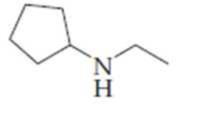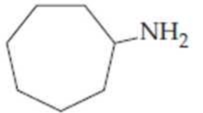
EBK FUNDAMENTALS OF GENERAL, ORGANIC, A
8th Edition
ISBN: 8220102895805
Author: Peterson
Publisher: PEARSON
expand_more
expand_more
format_list_bulleted
Textbook Question
Chapter 16, Problem 16.32AP
Name the following


Expert Solution & Answer
Want to see the full answer?
Check out a sample textbook solution
Students have asked these similar questions
Protein disulfide isomerase (PDI) is a protein folding enzyme that catalyzes disulfide-sulfhydryl exchange reactions.
Ribonuclease is an enzyme with two ẞ-sheets, three α-helices, and four disulfide bridges critical to the stability of its structure.
PDI rapidly converts inactive, scrambled ribonuclease to enzymatically active ribonuclease. This process is driven by the
decrease in free energy as the scrambled conformations are converted into the stable, active conformation of the enzyme. In
contrast, PDI rapidly inactivates insulin.
What does PDI's effect on insulin imply about the structure of insulin?
The three-dimensional shape of insulin does not contain any disulfide bonds.
The active conformation of insulin has more ẞ-sheets than α-helices.
The active conformation of insulin is not the most thermodynamically preferred form.
The amino acid sequence of insulin is similar to the amino acid sequence of ribonuclease.
In the 1950s, Christian Anfinsen demonstrated the renaturation of the protein ribonuclease (RNase) in vitro.
After reduction and the addition of urea, the protein was in an unfolded state. After removing the urea and then the reducing
agent, the protein oxidized and refolded, with greater than 90% activity. If reducing agent removal occurs before removing the
urea, the protein showed less than 5% activity.
Why does RNase refold incorrectly if the reducing agent is removed before urea removal?
Contaminants in the RNase preparation would form covalent bonds with the protein, preventing reactivation.
Urea would participate in weak bonding interactions with RNase, preventing oxidation of cysteine.
Disulfide bonds are not positioned correctly unless weak bonding interactions are present.
The protein would not fully denature.
A hospital blood processing unit uses apheresis to concentrate red blood cells (RBCs) fromwhole blood donations. Whole blood is drawn from a donor at a rate of 100 g/min and passedthrough a centrifuge-based apheresis system. The whole blood contains 45% RBC and 1%WBCs and platelets by mass, with the remainder consisting of plasma. The separated plasma andnon-RBC components are returned to the donor at a rate of 90 g/min.The goal of the system is to collect a concentrated RBC fraction containing 80% red blood cells.Assume that red blood cells do not break down during processing and that no fluid loss occurs inthe system.(a) How long will it take to collect 100g of the concentrated RBC fraction?
Chapter 16 Solutions
EBK FUNDAMENTALS OF GENERAL, ORGANIC, A
Ch. 16.2 - Identify the following compounds as primary,...Ch. 16.2 - Prob. 16.2PCh. 16.2 - Prob. 16.3PCh. 16.2 - Prob. 16.4PCh. 16.2 - Prob. 16.5KCPCh. 16.2 - Prob. 16.6KCPCh. 16.3 - Arrange the following compounds in order of...Ch. 16.3 - Draw the structures of (a) ethylamine and (b)...Ch. 16.4 - Provide compounds that fit the following...Ch. 16.4 - Prob. 16.10P
Ch. 16.4 - Prob. 16.11PCh. 16.5 - Write an equation for the acid-base equilibrium...Ch. 16.5 - Prob. 16.13PCh. 16.5 - Prob. 16.14PCh. 16.5 - Prob. 16.15PCh. 16.5 - Prob. 16.16PCh. 16.6 - Prob. 16.17PCh. 16.6 - Prob. 16.18PCh. 16.6 - Prob. 16.19PCh. 16.6 - Prob. 16.20PCh. 16.6 - Prob. 16.21PCh. 16.6 - Prob. 16.22PCh. 16.7 - Prob. 16.1CIAPCh. 16.7 - Prob. 16.2CIAPCh. 16.7 - Prob. 16.3CIAPCh. 16 - (a) For the compound above, identify each nitrogen...Ch. 16 - The structure of the amino acid lysine (in its...Ch. 16 - Prob. 16.25UKCCh. 16 - Prob. 16.26UKCCh. 16 - Prob. 16.27UKCCh. 16 - Complete the following equations: (a) (b)...Ch. 16 - Prob. 16.29APCh. 16 - Draw the structures corresponding to the following...Ch. 16 - Name the following amines, and classify them as...Ch. 16 - Name the following amines, and identify them as...Ch. 16 - Prob. 16.33APCh. 16 - Which is a stronger base, diethyl ether or...Ch. 16 - Prob. 16.35APCh. 16 - Prob. 16.36APCh. 16 - The compound lidocaine is used medically as a...Ch. 16 - Prob. 16.38APCh. 16 - Draw the structures of the ammonium ions formed...Ch. 16 - Prob. 16.40APCh. 16 - Prob. 16.41APCh. 16 - Prob. 16.42APCh. 16 - Prob. 16.43APCh. 16 - Prob. 16.44APCh. 16 - Prob. 16.45CPCh. 16 - Prob. 16.46CPCh. 16 - Prob. 16.47CPCh. 16 - Prob. 16.48CPCh. 16 - How do amines differ from analogous alcohols in...Ch. 16 - Name at least two undesirable characteristics are...Ch. 16 - Prob. 16.52CPCh. 16 - Complete the following equations (Hint: Answers...Ch. 16 - Prob. 16.54CPCh. 16 - Prob. 16.55CPCh. 16 - Why is cyclohexylamine not considered to be a...Ch. 16 - Prob. 16.57CPCh. 16 - Prob. 16.58GPCh. 16 - 1-Propylamine, 1-propanol, acetic acid, and butane...Ch. 16 - Prob. 16.60GPCh. 16 - Lemon juice, which contains citric acid, is...
Knowledge Booster
Learn more about
Need a deep-dive on the concept behind this application? Look no further. Learn more about this topic, biochemistry and related others by exploring similar questions and additional content below.Similar questions
- Please give an intuitive explanation of the blood-brain barrier. Specifically, what is it, what is its structure and function, what types of cells compose it, etc.,..?arrow_forwardObtain the sequence for the 5-HT receptor HTR1A and generate a hydropathy plot usingthe ExPASY tool ProtScale, the appropriate window, and the Kyte-Doolittle weightingalgorithm. How many transmembrane domains are present in this receptor?arrow_forwardFrom the reaction data below, determine whether the reaction is first order or second order and calculate the rate constant. Time (s) 0 Reactant (mM) 5.4 1 4.6 2 3.9 3 3.2 4 2.7 5 2.3 Only a plot of In[reactant] versus t gives a straight line, so the reaction is first order . The negative of the slope, k, is 0.171arrow_forward
- Hair grows at a rate of about 20 cm/yr. All this growth is concentrated at the base of the hair fiber, where a-keratin filaments are synthesized inside living epidermal cells and assembled into ropelike structures. Two-chan 14 Protofilament 20-30 A Two-chain Intermediate flament -Protob Protofilament Cross section of a hair The fundamental structural element of a keratin is the a helix, which has 3.6 amino acid residues per turn and a rise of 5.4 A perlum. 54A (36) Amino terminus Carbon Hydrogen Oxygen Nitrogen group Carboxyl terminus Assuming that the biosynthesis of a helical keratin chains is the rate-limiting factor in the growth of hair, calculate the rate at which peptide bonds of a-keratin chains must be synthesized (peptide bonds per second) to account for the observed yearly growth of hair. 0422 rate of peptide bond formation: Income bonds/sarrow_forwardSpecific rotation is a measure of a solution's capacity to rotate circularly polarized light. The unfolding of the a helix of a polypeptide to a random conformation is accompanied by a large decrease in specific rotation. Polyglutamate, a polypeptide made up of only 1-Glu residues, has the a helix conformation at pH 3. When researchers raise the pH to 7, there is a large decrease in the specific rotation of the solution. Similarly, polylysine (1.-Lys residues) is an a helix at pH 10, but when researchers lower the pH to 7 the specific rotation also decreases, as shown in the graph. a Helix Specific rotation Poly(Glu) a Helix Random conformation Poly(Lys) Random conformation T + ° 2 4 6 В 10 12 14 PH Complete the statements about the molecular mechanism for these changes in specific rotation. Increasing the pH of a polyglutamate solution from 6 to 7 causes the carboxyl group of each glutamate residue Comed Artwer lose a proton. The negatively charged groups in each glutamate residue…arrow_forwardFrom the reaction data below, determine whether the reaction is first order or second order and calculate the rate constant. Time (s) 0 Reactant (mM) 6.2 1 3.1 2 2.1 3 1.6 4 1.3 5 1.1 Only a plot of 1/[reactant] versus t gives a straight line, so the reaction is 0.150 mM-1 s-1 . S second order . The slope, k, isarrow_forward
- From the reaction data below, determine whether the reaction is first order or second order and calculate the rate constant. Time (s) 0 Reactant (mM) 5.4 1 4.6 2 3.9 3 3.2 4 2.7 5 2.3 Only a plot of In[reactant] versus t gives a straight line, so the reaction is s-1. . The negative of the slope, k, isarrow_forwardA protein has a molecular mass of 400 kDa when measured by size-exclusion chromatography. When subjected to gel electrophoresis in the presence of sodium dodecyl sulfate (SDS), the protein gives three bands with molecular masses of 180, 160, and 60 kDa. When electrophoresis is carried out in the presence of SDS and dithiothreitol (DTT), three bands again form, this time with molecular masses of 160, 90, and 60 kDa. How many subunits does the protein have, and what is the molecular mass of each? four subunits: 180, 160, 90, and 60 kDa three subunits: 180, 160, and 60 kDa three subunits: 160, 90, and 60 kDa four subunits: 160, 90, 90, and 60 kDa Correct Answerarrow_forwardCalculate KM and Vmax from the following data: KM= i Vmax [S] (μM) vo (mM.s-¹) 0.1 0.34 0.2 0.53 0.4 0.74 0.8 0.91 1.6 1.04 μM mM s-1arrow_forward
- Propose a detailed chemical mechanism for the enzyme catalyzed reaction below and briefly note similarities, if any, to enzymes that we've studied. CO2 + CO2 2 CO2 HO CH3arrow_forwardState and describe the four stages of protein formation, please include the types of bonds at each stage.arrow_forwardPlease state and describe the four different types of non-covalent interactions.arrow_forward
arrow_back_ios
SEE MORE QUESTIONS
arrow_forward_ios
Recommended textbooks for you
 Principles Of Radiographic Imaging: An Art And A ...Health & NutritionISBN:9781337711067Author:Richard R. Carlton, Arlene M. Adler, Vesna BalacPublisher:Cengage Learning
Principles Of Radiographic Imaging: An Art And A ...Health & NutritionISBN:9781337711067Author:Richard R. Carlton, Arlene M. Adler, Vesna BalacPublisher:Cengage Learning Human Physiology: From Cells to Systems (MindTap ...BiologyISBN:9781285866932Author:Lauralee SherwoodPublisher:Cengage Learning
Human Physiology: From Cells to Systems (MindTap ...BiologyISBN:9781285866932Author:Lauralee SherwoodPublisher:Cengage Learning


Principles Of Radiographic Imaging: An Art And A ...
Health & Nutrition
ISBN:9781337711067
Author:Richard R. Carlton, Arlene M. Adler, Vesna Balac
Publisher:Cengage Learning




Human Physiology: From Cells to Systems (MindTap ...
Biology
ISBN:9781285866932
Author:Lauralee Sherwood
Publisher:Cengage Learning
GCSE Chemistry - Acids and Bases #34; Author: Cognito;https://www.youtube.com/watch?v=vt8fB3MFzLk;License: Standard youtube license